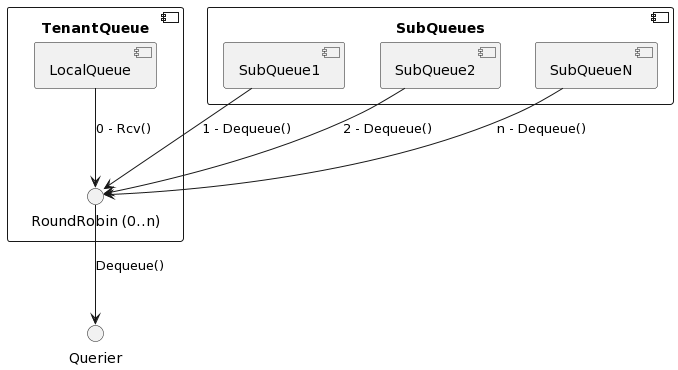This is documentation for the next version of Grafana Loki documentation. For the latest stable release, go to the latest version.
Ensure query fairness within tenants using actors
Loki uses shuffle sharding to minimize impact across tenants in case of querier failures or misbehaving neighboring tenants.
When there are potentially a lot of different actors using the same tenant to query logs, such as users accessing Loki from Grafana or via LogCLI or other applications using the HTTP API, it can lead to contention between queries of different users, because they all share the same resources for a tenant.
In that case, as an operator, you would also want to ensure some sort of query fairness across these actors within the tenants. An actor could be a Grafana user, a CLI user, or an application accessing the API. To achieve that, Loki introduced hierarchical scheduler queues in version 2.9 based on LID 0003: Query fairness across users within tenants and they are enabled by default.
What are hierarchical queues and how do they work
To understand hierarchical queues, we first need to know that in the scheduler component each tenant has its own first in first out (FIFO) queue where sub-queries are enqueued. Sub-queries are queries that result from splitting and sharding of a query sent by a client using HTTP.
Tenant queues are the first level of the queue hierarchy. When a tenant executes a query without any further controls, all of its sub-queries are enqueued to the first level queue.
The second level of the queue hierarchy is that the tenant can have sub-queues.
Similar to how shuffle sharding assigns queries at the tenant level, each time the Loki Scheduler makes a round-robin pick at the second level of the query hierarchy, it selects a query from the tenant’s local queue and subqueues.

The figure above shows that a tenant queue has a local queue, which is a leaf node in the queue tree, and a set of sub-queues. Each sub-queue, again like the tenant queue, consists of a local queue, and possible sub-queues, resulting in a recursive tree structure.
So, how can we make use of these tree-like queue structures to achieve query fairness?
How to control query fairness
As already mentioned, by default, sub-queries are only enqueued at the first
(tenant) level of the queue tree. The tenant is provided by the X-Scope-OrgID
header that is required when running Loki in multi-tenant mode.
You use the HTTP header X-Loki-Actor-Path to control to which sub-queue a
query (or more correctly its sub-queries) is enqueued.
The following example shows a curl command that invokes the HTTP endpoint for range queries
and passes both the X-Scope-OrgID and the X-Loki-Actor-Path headers.
curl -s http://localhost:3100/loki/api/v1/query_range?xxx \
-H 'X-Scope-OrgID: grafana' \
-H 'X-Loki-Actor-Path: joe'The query that this request invokes ends up in the sub-queue joe of the
tenant queue grafana. Another user can use their own name in the actor path
header to enqueue their queries to their own sub-queue.
Since the scheduler chooses the next task for a tenant in a round-robin manner, both actors (in our case human users) get their 50% share when the scheduler dequeues a sub-query to send to the querier.
With N actors, each actor gets 1/Nth of their share. In our example with two users, even when there are sub-queries in the local queue of the tenant, the local queue gets 1/3 and each sub-queue gets 1/3 of their share.
As the explained implementation and the header name already suggest, it is
possible to enqueue queries several levels deep. To do so, you can construct a
path to the sub-queue using the | delimiter in the header value, as shown in
the following examples.
curl -s http://localhost:3100/loki/api/v1/query_range?xxx \
-H 'X-Scope-OrgID: grafana' \
-H 'X-Loki-Actor-Path: users|joe'
curl -s http://localhost:3100/loki/api/v1/query_range?xxx \
-H 'X-Scope-OrgID: grafana' \
-H 'X-Loki-Actor-Path: apps|logcli'There is a limit to how deep a path and thus the queue tree can be. This is
controlled by the Loki -query-scheduler.max-queue-hierarchy-levels CLI argument
or its respective YAML configuration block:
query_scheduler:
max_queue_hierarchy_levels: 2 # defaults to 3It is advised to keep the levels at a reasonable level (ideally 1 to 3 levels), both for performance reasons as well as for the understanding of how query fairness is ensured across all sub-queues.
Enforcing headers
In the examples above the client that invoked the query directly against Loki also provided the HTTP header that controls where in the queue tree the sub-queries are enqueued. However, as an operator, you would usually want to avoid this scenario and control yourself where the header is set.
When using Grafana as the Loki user interface, you can, for example, create multiple data sources
with the same tenant, but with a different additional HTTP header
X-Loki-Actor-Path and restrict which Grafana user can use which data source.
Alternatively, if you have a proxy for authentication in front of Loki, you can pass the (hashed) user from the authentication as downstream header to Loki.




